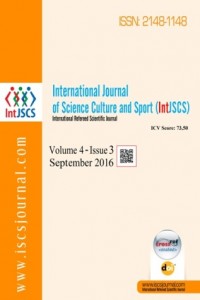Evaluation of Ergonomic Postures of Physical Education and Sport Science by REBA and Its Relation to Prevalence of Musculoskeletal Disorders
Öz
Postural abnormalities of regions predispose individuals to chronic pain. Because of improper position of students, who are growing, the risk of adopting abnormal postures is common. In order to establish appropriate strategies to prevent these impairments, having accurate information about them is necessary. The purpose of this study was to evaluation of ergonomic postures of physical education and sport science by REBA and its relation to prevalence of musculoskeletal disorders. In the present cross-sectional study, 260 subjects of physical education and sport science were selected randomly and interviewed. To determine the prevalence of musculoskeletal disorders and assessment of postures, we used Nordic Musculoskeletal Questionnaire (NMQ) and Rapid Entire Body Assessment (REBA) respectively. Using SPSS IBM 20 software, data were analyzed by chi-square and independent sample t-test. The Rapid Entire Body Assessment results indicated that 40% of participant, equivalent to 104 subjects obtained from 4 to 7 scores (very high risk level). Also, Results of the Nordic questionnaire indicated that the highest musculoskeletal disorder report was related to low back region with 50.8 % and the least common complaints were related to elbows and feet with prevalence rates of 20 and 26%, respectively. It seems that long duration of daily seating and repetitive its and maladjustment of the seat height in proportion were effective factors leading to the high prevalence of musculoskeletal disorders among physical education and sport science students of Gazi University-Turkey which was also confirmed by posture assessment results. Timely adjustment of the seat height through designing adjustable seats and following ergonomic principles in school might be useful strategies to reduce prevalence of musculoskeletal disorders.
Kaynakça
- Boocock MG, McNair PJ, Larmer PJ et al (2007). Interventions for the prevention and management of neck/upper extremity musculoskeletal conditions: a systematic review. Occup Environ Med. 64:291-303.
- Burgess-Limerick R (2003). Issues associated with force and weight limits and associated threshold limit values in the physical handling work environment. Unpublished document Division of workplace health and safety, Department of Industrial relations. Queensland. p:146-150.
- Chen KM, Chen MH, Hong SM et al. (2008). Physical fitness of older adults in senior activity centers after 24-week silver yoga exercises. J Clin Nurs. 17:2634 2646.
- Erick P, Smith D (2013). Musculoskeletal disorder risk factors in the teaching profession: a critical review. OA Musculoskeletal Medicine. 1:29.
- Hıgnett S, Mc Atamney L (2000). Rapid entire body assessment (REBA). Appl Ergon. 31,201 205.
- Lee KU, Kyeon JI, Kim HS, et al. (2000). Back exercise program with lumbar extension resisting exercise in patients with chronic low back pain. Annals of Rehab Med. 24: 536–541.
- Moon HH (2007). The effect of correction exercise program on primary school students with idiopathic scoliosis. J Sport Leis Stud. 31: 1033–1041.
- Park MJ, Park JS (2003). Effect of a posture training program on Cobb angle and knowledge of posture of elementary school students. Taehan Kanho Hakhoe Chi, 33: 643–650.
- Riihimäki H (2000). Methodological issues in epidemiologic studies of musculoskeletal disorders. In: Violante F, Armstrong T, Kilbom A, editors. Occupational ergonomics: work-related musculoskeletal disorders of the upper limb and back. 1st ed: Taylor & Francis. P:1-10.
- Soroush M, Hassani H (2015). Musculoskeletal complaints associated with computer use and its ergonomic risks for office workers of a medical sciences university in Tehran. Ann Mil Health Sci Res. 13 (1):2-6
- Stock SR (1991). Workplace ergonomic factors and the development of musculoskeletal disorders of the neck and upper limbs: a metaanalysis. Am J Ind Med. 19(1):87-107.
Öz
Kaynakça
- Boocock MG, McNair PJ, Larmer PJ et al (2007). Interventions for the prevention and management of neck/upper extremity musculoskeletal conditions: a systematic review. Occup Environ Med. 64:291-303.
- Burgess-Limerick R (2003). Issues associated with force and weight limits and associated threshold limit values in the physical handling work environment. Unpublished document Division of workplace health and safety, Department of Industrial relations. Queensland. p:146-150.
- Chen KM, Chen MH, Hong SM et al. (2008). Physical fitness of older adults in senior activity centers after 24-week silver yoga exercises. J Clin Nurs. 17:2634 2646.
- Erick P, Smith D (2013). Musculoskeletal disorder risk factors in the teaching profession: a critical review. OA Musculoskeletal Medicine. 1:29.
- Hıgnett S, Mc Atamney L (2000). Rapid entire body assessment (REBA). Appl Ergon. 31,201 205.
- Lee KU, Kyeon JI, Kim HS, et al. (2000). Back exercise program with lumbar extension resisting exercise in patients with chronic low back pain. Annals of Rehab Med. 24: 536–541.
- Moon HH (2007). The effect of correction exercise program on primary school students with idiopathic scoliosis. J Sport Leis Stud. 31: 1033–1041.
- Park MJ, Park JS (2003). Effect of a posture training program on Cobb angle and knowledge of posture of elementary school students. Taehan Kanho Hakhoe Chi, 33: 643–650.
- Riihimäki H (2000). Methodological issues in epidemiologic studies of musculoskeletal disorders. In: Violante F, Armstrong T, Kilbom A, editors. Occupational ergonomics: work-related musculoskeletal disorders of the upper limb and back. 1st ed: Taylor & Francis. P:1-10.
- Soroush M, Hassani H (2015). Musculoskeletal complaints associated with computer use and its ergonomic risks for office workers of a medical sciences university in Tehran. Ann Mil Health Sci Res. 13 (1):2-6
- Stock SR (1991). Workplace ergonomic factors and the development of musculoskeletal disorders of the neck and upper limbs: a metaanalysis. Am J Ind Med. 19(1):87-107.
Ayrıntılar
| Bölüm | Makaleler |
|---|---|
| Yazarlar | |
| Yayımlanma Tarihi | 27 Eylül 2016 |
| Yayımlandığı Sayı | Yıl 2016 Cilt 4 - Sayı 3 |


